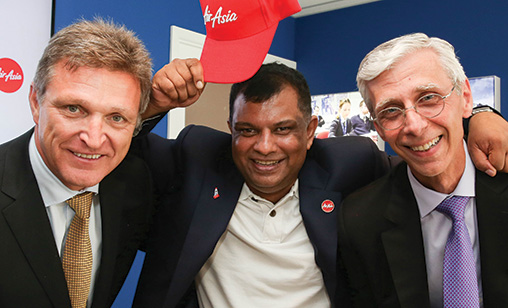Industry Insight Special Report
Beyond the simulator
The AirAsia Group and Canada’s CAE are testing a Next Gen training system for pilots that seeks to erase industry doubts about current cockpit teaching.
November 1st 2016
This month, Canadian simulator manufacturer and pilot training group, CAE, and the AirAsia Group will begin testing a pilot training system intended to improve the objective performances of pilots by exploiting the brave new world of data analytics. Read More »
The Next Generation Training System, which has been installed on one of the Airbus A320 simulators at the Asian Aviation Centre of Excellence (AACE) in Kuala Lumpur, is being heralded by CAE as a breakthrough in the industry.
 |
Said Nick Leontidis, CAE’s Group President, Civil Aviation Training Solutions: “Supported by innovative data collection and analysis techniques, this system promises to improve training quality and efficiency by integrating untapped data-driven insights into training.”
And as the debate continues about pilots’ reliance on automation in the cockpit, CAE said the new system will train pilots to fly commercially as well as teach them to react appropriately when things go wrong.
“The basic notion behind our Next Gen Training System is to give instructors a better capability to objectively measure the critical skills needed by pilots. We also need methods to train people for a particular airline’s requirements,” said Leontidis.
“We have developed a system where pilots can have their skills measured in critical situations. The training is a structured list of skills that must be mastered. We will measure those skills and do it in a way that the airline wants the measurements done.
“We will give the instructor the ability not only to subjectively assess the performance of a trainee, but also the ability to deliver an objective assessment [of the trainee].”
While manual flying is one of the skills a pilot must master, Leontidis said it is airlines that dictate the amount of manual flying their pilots must do in their Standard Operating Procedures (SOP).
“Manual flying is an area of discussion and debate, but there are others issues too. Upset prevention and recovery is one. There have been incidents where people have stalled aircraft and unfortunately that has resulted in loss of life,” he said.
“We believe we don’t need to teach people manual flying, but we need to train them to get out of trouble when they are in trouble. These are the times when most of these accidents have occurred. Pilots get into trouble and do not recognize the situation they are in. This puts them in a place where the aircraft is uncontrollable.
“I think most pilots, even the younger ones, understand how to fly an aircraft in a controlled environment. It’s the uncontrolled environment that is the threat.”
| 'Pilots have to be ready for that moment when something does go wrong. It’s not learning ‘hey, here’s how an A350 flies around’. It’s what you do when the A350 decides it does not want to fly anymore' |
| Nick Leontidis CAE’s Group President, Civil Aviation Training Solutions |
“We think upset prevention and recovery training should be added to training programs. Many airlines have made it part of their pilot training and it is included in CAE’s curriculum as well,” he said.
“Pilots have to be ready for that moment when something does go wrong. It’s not learning ‘hey, here’s how an A350 flies around’. It’s what you do when the A350 decides it does not want to fly anymore.”
Leontidis said Next Gen training has been developed because there are a lot of young pilots in the system and it would be beneficial to know if they are operating correctly. If they are not, the system can catch them early and correct their mistakes.
“We are looking for insights about what is going on. It’s useful to the individual because the results are assessed objectively. It’s useful to the instructor because he can decide how to help if required. It’s useful for management because they will have a better understanding of their pilots.
“Everybody wins in this type of system. We believe it will bring the quality of the training to another level.”
CAE’s Asia-Pacific business is thriving. It has 15 training schools across the region: Asia (9), India (4) and Australia (2). “Our big operations are in Zhuhai, southern China, Kuala Lumpur and Tokyo,” said Leontidis.
There also is a training centre in Singapore, part of its joint venture with AirAsia, as well as joint venture centres with Cebu Pacific, China Southern Airlines, China Eastern Airlines and Japan Airlines (JAL).
In August, CAE signed a five-year commercial aviation training contract with South Korean budget carrier, Air Seoul, for the training of the carrier’s A320 cockpit crew. Air Seoul pilots began their CAE training on August 1 at the CAE Korea Training Centre.
Earlier in the year, the company agreed to a training equipment contract that included the sale of three Boeing 737MAX, a simulator A320NEO and an ATR72-600, to support Indonesian LCC, Lion Air’s, expanding training requirements. It also has extended its existing training contracts with South Korea’s Jeju Air and Japan Airlines (JAL). The JAL contract, a Multi-Crew Pilot License (MPL) First Officer Program, has been extended by three years to 2023.
“We have the capacity to do more. We see ourselves adding more simulators, more instructors and more capacity to train people,” Leontidis said.